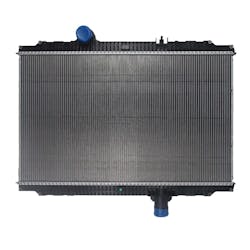Guest Blog: Maintain engine cooling systems to avoid summer downtime
Routine maintenance on big rigs is a must to keep vehicle performance from slipping; and with another changing season comes new upkeep focal points on trucks for drivers to possibly replace before they hit the open road. In the rainy months of spring, truckers pay closer attention to repairs on their truck’s air brake and suspension systems; but with summer, truck drivers need to maintain their truck’s engine cooling systems. After all, it is scorching hot across the country; and trucks are feeling the heat (as are we). Learn the parts of the engine cooling system to care for during the hot months of summer.
Anatomy of a truck’s engine cooling system
There are six main parts that work in harmony to create a fully functioning cooling system, including the cooling fan, radiator, water pump, thermostat, rubber hoses, and anti-freeze/coolant. If one component goes bad, it could create a ripple effect that will send your vehicle to a nearby repair shop.
Water pump: Considered the heartbeat of a vehicle’s cooling system, the water pump’s responsibility is to continuously circulate coolant from the radiator throughout the entire system. If your truck begins to overheat, it could be signs of a failing water pump.
Anti-freeze/coolant: There are different colors of coolant; and the type used will depend on your vehicle. Regardless of color, the coolant’s job is to flow through the engine and transfer heat to the outside air inside the radiator.
Cooling fan: When coolant gets too hot, this unit is designed to turn on until the liquid returns to a cooler temperature.
Radiator: The radiator’s job is to remove the transferred heat passed on from the coolant to the outside air—thus cooling the engine. The cooling system begins and ends with the radiator.
Thermostat: This open/closed positioning valve helps facilitate cooling operations by allowing the coolant to circulate throughout the engine at a cool, optimal temperature.
Rubber hoses: The connectors of the system, hoses are used to flow coolant from the radiator to the engine.Warning signs of engine cooling system failure
The most common indication of a failing engine cooling system is an overheating vehicle; and while this is a big one that will inevitably delay shipments, ruin a good day, and cost plenty in engine repairs, there are other warning signs that will occur before the engine overheats.
Rising temperature gauge: This may be your first sign of trouble. If you notice the needle dive into the red “danger” zone, pull over immediately.
Low coolant levels: Always check coolant fluids before long-haul trips. If it drops, you may have a leak.
Smoke: It could be from burnt coolant in the chamber or a blown gasket. Nevertheless, it could mean the vehicle is overheating and you will need to repair the engine soon.
How to avoid engine cooling system problems
Of course, routine maintenance is always the answer; but before you burn a hole in your wallet, make sure to do your prep work. Additionally, the suggestions below are just that, suggestions; please refer to your specific truck’s operator’s manual and service documentation for more information on your truck’s cooling system. Let’s go back to the six engine cooling system components.
Water pump: Heavy-duty vehicle operators should replace pumps every 60,000—90,000 miles. Check pumps for broken seals, bad bearings, and system contamination including cavitation before paying the price to repair.
Anti-freeze/coolant: This clear liquid should be above the “cold minimum line” on your coolant reservoir tank. Most semi-trucks require 12—14 gallons total. Check often and refill, if necessary.
Cooling fan: There is no scheduled maintenance for cooling fans. Instead, test before big trips. Start by using a volt reader to check for power to the wires (12V is normal). If there is power, then you can rule this out as a potential problem. If you hear odd noises from the engine, or see a decrease in coolant levels or an increase in temperature, you should replace the fan to be safe.
Radiator: Inspect the radiator for corrosion and the radiator cap for cracks and swelling. Check coolant to make sure it is pure—free from contaminants—as well. If there is sludge build-up in the radiator, or coolant leaks, replace the radiator.
Thermostat: It should be replaced every two years. The good news is that it will not cost a lot in maintenance expenses.
Rubber hoses: When examining the radiator, inspect the hoses for cracks and leaks. Replace every two years along with belts and tensioner arms.
Final thought
The best way to protect your heavy-duty vehicle from downtime in the summer season is to inspect and replace the top engine cooling system parts that work hard to keep your engine running at its peak performance. Research aftermarket truck parts from trusted brands such as BorgWarner, Dayco, Haldex, and Match Made. Watch video tutorials for simple installation of these parts and refer to your truck’s operator’s manual. With these helpful truck maintenance tips, you will have little to worry about this season except for how to keep cool yourself.
Information provided by JIT Truck Parts.
About the Author

Jennifer Smith
e-Commerce Digital Content Strategist
Jennifer Smith is an e-Commerce Digital Content Strategist with JIT Truck Parts in Highland Park, Illinois. JIT Truck Parts is a national aftermarket truck parts distributor servicing national, regional, and local fleets. With distribution centers located throughout the U.S., JIT offers parts from leading manufacturers—delivered any place, on time, with a commitment to customer service.

